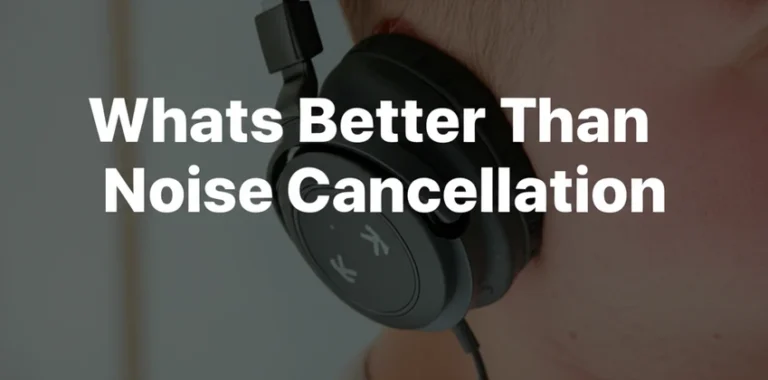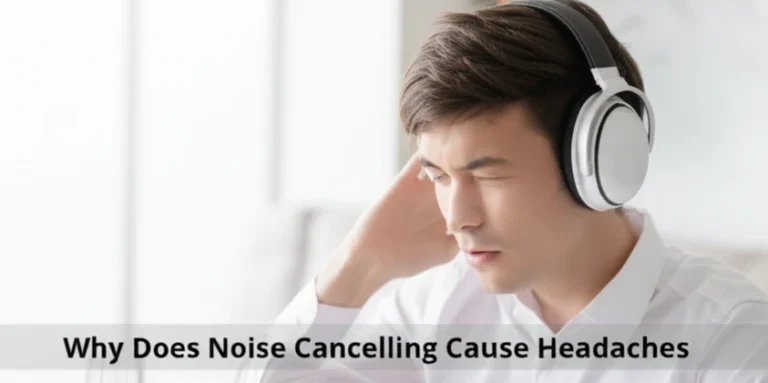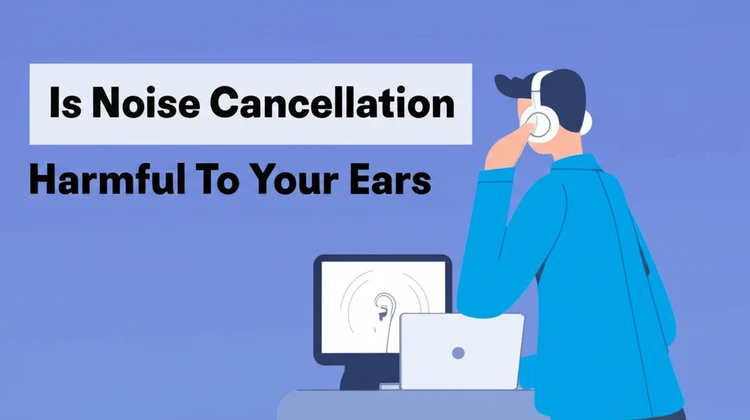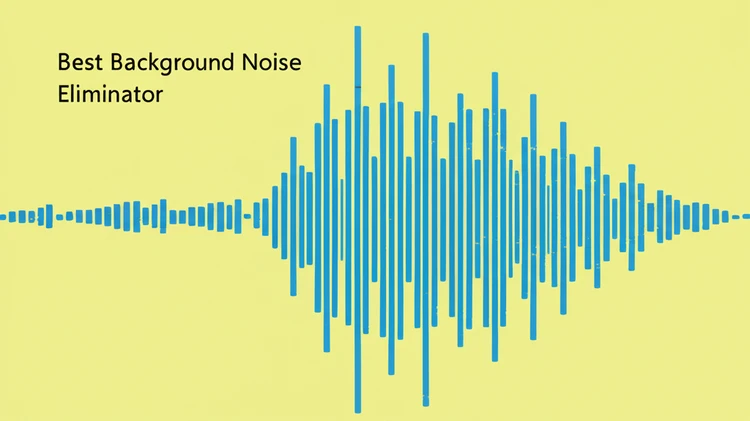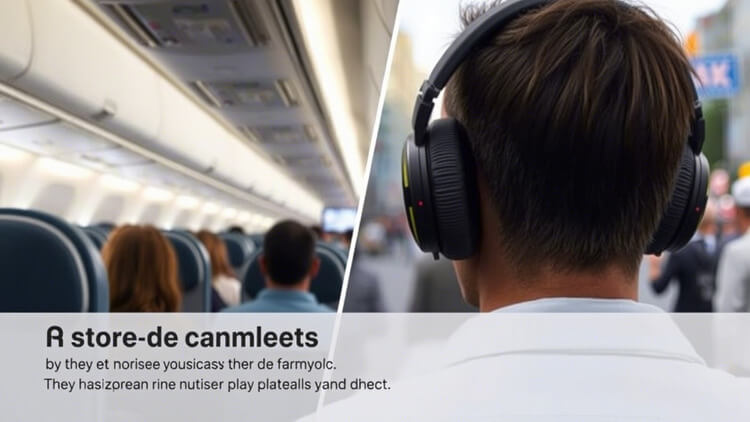
Many people associate noise-cancelling headphones with enjoying music, but they’re also incredibly effective at creating a quieter environment even without music playing. This raises the question: does noise cancelling work without music? The answer is a resounding yes.
Both active and passive noise cancellation technologies function independently of audio playback, making these devices useful for a variety of situations beyond just listening to music. This article explores how noise-cancelling technology works without music, its benefits, and tips for maximizing its effectiveness.
Noise-Cancelling Technology: How It Works
Noise-cancelling technology aims to reduce unwanted ambient sounds, creating a more peaceful and focused environment. This is achieved through two primary methods: active and passive noise cancellation, each targeting different types of noise.
Active Noise Cancellation (ANC)
Active Noise Cancellation (ANC) uses a sophisticated system to counteract external noise.
Small microphones built into the headphones detect incoming sound waves. The headphones then generate “anti-noise” – inverse sound waves that mirror the frequency and amplitude of the unwanted noise. When these two opposing waves meet, they effectively cancel each other out, reducing the perceived volume of the ambient sound.
This method is particularly effective at neutralizing consistent, low-frequency sounds like the drone of airplane engines, the hum of an air conditioner, or the rumble of a train.
However, ANC isn’t a magic bullet. It has some limitations:
- Less effective against high-frequency and erratic noises: ANC struggles with higher-pitched sounds like voices, sudden noises like a door slamming, or inconsistent sounds like keyboard typing. These sounds are harder to predict and counteract effectively.
- Potential latency: Some ANC systems introduce a minor delay (latency) between detecting and neutralizing noise.
This latency is usually imperceptible in most situations but might be noticeable in specific scenarios.
- Variable performance: ANC effectiveness depends on factors like the headphone model, how well the earcups seal around your ears, and the processing power of the headphones’ internal circuitry.
Study Findings:
A study by Bose (citation needed) found that ANC can reduce low-frequency noise by up to 30 decibels (dB), a significant reduction that makes noisy environments much more tolerable. A decibel is a unit used to measure the intensity of a sound. A 30 dB reduction represents a substantial decrease in perceived loudness.
Passive Noise Cancellation (PNC)
Passive Noise Cancellation (PNC) relies on the physical design of the headphones to block sound.
This includes features like padded earcups made of sound-absorbing materials and a tight seal around the ears. The materials and design create a barrier that physically attenuates incoming sound waves, particularly effective for high-frequency noises like human speech. Unlike ANC, PNC doesn’t require any power.
Buying Tip:
When selecting headphones for passive noise isolation, look for earcups made of memory foam, which conforms to the shape of your ear, creating a better seal.
Also, consider the clamping force – the pressure the headphones exert on your head. A firmer clamping force generally provides better noise isolation but can become uncomfortable over extended periods. Find a balance that suits your needs and comfort level.
Does Noise Cancelling Work Without Music?
Yes, noise cancelling absolutely works without music.
In fact, the core purpose of noise-cancelling technology is to reduce background noise, regardless of whether music is playing. Let’s examine how ANC and PNC function independently of music playback.
ANC Without Music
Even in silence, ANC continues to actively analyze and neutralize low-frequency background sounds such as:
- Airplane or train engines
- HVAC systems
- Office hums
Battery Usage:
While ANC does consume battery power even without music playing, modern headphones have become more power-efficient. For instance, the Sony WH-1000XM5 offers up to 30 hours of ANC-only use.
Other models may provide different battery life, typically ranging from 20-40 hours in ANC mode without music. This makes them practical for extended periods of noise reduction without needing frequent recharges.
PNC Without Music
PNC is always active due to the headphone’s physical construction. Whether the headphones are powered on or off, the earcup materials and design continuously provide passive noise reduction.
This makes PNC especially helpful in unpredictable environments where sudden loud noises might occur.
Benefits of Noise Cancelling Without Music
Using noise-cancelling headphones without music offers numerous benefits:
- Improved Focus & Productivity: By reducing distractions in noisy environments, noise cancelling can significantly enhance concentration, allowing for increased productivity in places like offices, libraries, or coffee shops.
- Stress Reduction: Continuous exposure to noise can contribute to stress. Noise-cancelling headphones create a quieter personal space, minimizing the auditory overload that can lead to anxiety and tension.
- Better Sleep & Relaxation: Whether dealing with noisy neighbors, traffic sounds, or snoring partners, noise-cancelling headphones can promote better sleep and relaxation by creating a more peaceful environment. This is particularly beneficial for travelers or light sleepers.
- Versatile Applications: The ability to reduce background noise makes noise-cancelling headphones useful in a variety of settings, including studying, working from home, commuting, attending lectures, or simply relaxing in a noisy environment.
Comparing Noise Cancelling With and Without Music
| Feature | ANC Without Music | ANC With Music |
|---|---|---|
| Effectiveness | Strong for low-frequency noise | Strongest overall, as music further masks residual noise |
| Battery Usage | Moderately high drain | Slightly higher drain due to audio playback |
| Use Case | Studying, relaxing, focusing, traveling, sensory sensitivity | Immersive listening, calls, media consumption, blocking distractions while listening |
| Comfort | Can be worn for extended periods, especially with comfortable earcups | Same as without music; comfort depends on headphone design |
| Price Range | Same as with music; varies by brand and features | Same as without music; varies by brand and features |
| Noise Types Blocked | Primarily low-frequency, continuous sounds | Wider range of frequencies, with music masking some higher frequencies |
Scenarios Where ANC Without Music is Useful
Traveling
Noise-cancelling headphones are a traveler’s best friend.
They effectively reduce the constant drone of airplane engines, the rumble of train tracks, and the general chatter of fellow passengers. This creates a much more relaxing travel experience, whether you’re trying to sleep, read, or simply enjoy some peace and quiet on a long journey. Consider a compact, foldable design for easy packing.
Office Use
In open-plan offices or shared workspaces, noise-cancelling headphones can be indispensable for maintaining focus.
They help minimize distractions like keyboard clicking, conversations, and the general office hum, allowing you to concentrate on your tasks without constant interruptions. Look for models with good microphone quality if you need to take calls.
Home Environments
Even at home, noise-cancelling headphones can create a sanctuary of quiet. They can block out the noise of household appliances, traffic from outside, or the sounds of family members.
This makes them ideal for creating a focused workspace, enjoying a quiet moment of relaxation, or simply escaping into a good book without auditory distractions.
Studying
Whether in a library, coffee shop, or dorm room, noise-cancelling headphones can create a dedicated study zone. By minimizing external distractions, they promote deeper focus and concentration, crucial for effective learning and information retention.
Sensory Sensitivity
For individuals with sensory sensitivities, noise-cancelling headphones can be a valuable tool for managing overwhelming auditory stimuli. By reducing background noise, they can help create a more calming and manageable sensory experience in everyday life.
Tips for Optimizing Noise Cancelling Without Music
To get the most out of your noise-cancelling headphones without music:
- Choose High-Quality Devices: Invest in headphones from reputable brands known for their noise-cancelling technology.
Research reviews and comparisons to find models that suit your needs and budget. Look for features like adjustable ANC levels and transparency modes.
- Ensure a Proper Fit: A snug, comfortable fit is essential for maximizing both active and passive noise cancellation. Experiment with different earcup sizes or materials to find the best seal for your ears.
Adjust the headband to achieve a secure yet comfortable fit.
- Adjust ANC Settings (if available): Some headphone models offer adjustable ANC levels, allowing you to fine-tune the noise cancellation to your environment. Experiment with these settings to find the optimal balance between noise reduction and comfort. Some headphones also offer a “transparency” mode that allows you to hear external sounds when needed.
- Maintain Device Performance: Keep your headphone’s firmware updated for optimal performance.
Regularly clean the earcups to remove dirt and oils that can affect the seal and noise cancellation effectiveness.
FAQ
Does ANC work in total silence?
Yes, ANC still functions in a quiet environment. It actively analyzes the surrounding soundscape and neutralizes any ambient noise it detects, even if the noise level is already low.
How much noise does ANC cancel?
Most ANC headphones are designed to reduce low-frequency noise by 20-30 dB, although the exact amount varies depending on the specific model, environment, and how well the headphones seal around the ears. Independent reviews and technical specifications can provide more detailed information on a particular model’s noise-cancellation performance.
Are noise-cancelling headphones safe for daily use?
Yes, noise-cancelling headphones are generally safe for daily use.
However, some users may experience slight ear pressure or a “suction” sensation, especially with prolonged use. If you experience any discomfort, take regular breaks to allow your ears to equalize pressure. Consult a doctor if you have any concerns about using noise-cancelling headphones.
Can I use noise-cancelling headphones with hearing aids?
Some noise-cancelling headphones can be used comfortably with hearing aids, but it depends on the individual and the specific models of both devices.
Over-ear headphones are often a better choice than in-ear models for compatibility with hearing aids. It’s advisable to consult with an audiologist for personalized recommendations.
Do noise-cancelling headphones protect my hearing?
While noise-cancelling headphones help reduce unwanted noise, they don’t offer direct hearing protection in the same way earplugs or earmuffs designed for that purpose do. They primarily reduce background noise to improve comfort and concentration, but they won’t fully block extremely loud sounds that could damage your hearing.
Conclusion
Noise-cancelling headphones offer far more than just an enhanced music experience.Their ability to create a quieter environment, even without music playing, makes them a valuable tool for improving focus, reducing stress, enhancing sleep quality, and managing sensory overload.
Whether you’re navigating a noisy commute, working in a busy office, seeking tranquility at home, or striving for focused study sessions, noise-cancelling headphones offer a versatile solution for finding peace and quiet in a world filled with sound. By understanding how noise cancelling works without music and choosing the right model for your needs, you can significantly improve your comfort and productivity in various environments.


